Physical Address
304 North Cardinal St.
Dorchester Center, MA 02124
Perhaps no finding on echocardiography creates a bigger diagnostic challenge than the presence of an intracardiac mass. This is because tissue characterization by any imaging modality is limited. The advent of tomographic imaging in general, including computed tomography (CT), magnetic resonance imaging, and echocardiography, has dramatically improved the detection of intracardiac masses, but mass characterization remains challenging. The diagnosis of some masses, particularly thrombi, can be reasonably certain on the basis of the company that they keep, such as the association of thrombi and regional wall motion abnormalities. Likewise, papillary fibroelastomas are classically seen on the ventricular side of the semilunar valves, and atrial myxomas frequently attach to the interatrial septum. Angiosarcomas typically originate from a vascular structure, particularly the inferior or superior vena cava.
Beyond these generalities, additional deductive reasoning is limited when it comes to the diagnosis of an intracardiac mass. Although real-time three-dimensional echocardiography (RT3DE) can add some information about the tissue characterization of cardiac masses, its true strengths are accurate assessment of size and volume of the mass as well as the relationship of the mass to adjacent cardiac structures. Both RT3D transthoracic echocardiography (TTE) and more recently RT3D transesophageal echocardiography (TEE) have been extensively used, even within the brief time of their existence, for imaging cardiac masses.
3DE imaging took a major step in 2002, when previous gated methods of 3DE acquisition were replaced with RT3DTTE. In 2007, RT3DTEE imaging became available, revolutionizing the evaluation of intracardiac masses.
The potential and realized benefits of 3DE for mass evaluation include (1) improved spatial relationships to adjacent anatomic structures; (2) improved accuracy of size and volume of the masses; (3) improved detail of the homogeneity (or lack thereof) of the mass using the cropping function of 3D software; (4) involvement or noninvolvement of adjacent structures, such as interatrial or interventricular septum, valves, or myocardium; and (5) mobility in 3D space and, as a correlate, identification of the stalk of the mass, if present.
The differential diagnosis of an intracardiac mass includes thrombus, vegetation, tumor, iatrogenic material, extracardiac tissue, and normal variant. Narrowing the diagnosis down by 2DE and then 3DE should be and is the goal of imaging. As mentioned, tissue characterization remains the holy grail of imaging and, as such, remains challenging. However, characteristics such as inhomogeneity suggest tumor, whereas a highly homogeneous sessile mass is more characteristic of a thrombus. However, clot lysis does exist, presenting a highly inhomogeneous look, and thrombi can be quite mobile. A clear stalk has been believed to suggest tumor, but thrombi occasionally are attached to clear stalks as well. Further details are provided with each individual discussion of masses that follows.
Primary tumors of the heart are extremely rare, with a reported prevalence of 0.001% to 0.03% by autopsy series. The most common primary cardiac tumor is the myxoma, even though myxoma is relatively uncommon. Myxomas are most common in the atria, particularly the left atrium. They often have a clear stalk attached to the interatrial septum and clearly visualized with 3DE. Myxomas typically are benign, but the most common primary malignant tumors are sarcomas, which are highly invasive and uniformly fatal tumors. Angiosarcoma is the most common of this group. Metastatic tumors to the heart are much more common than are primary tumors, with the most common being breast and lung tumors; the usual cardiac site of metastasis is the pericardium. In fact, secondary involvement of the heart by extracardiac tumors is 20 to 40 times more common compared with primary cardiac tumors. Melanoma is a tumor that has particular propensity to metastasize to the heart.
As mentioned, myxomas are the most common primary cardiac tumors ( Figures 16-1 to 16-3 ; Videos 16-1 to 16-6 ). 3D imaging of atrial myxomas has been reported by transthoracic and transesophageal methods. The main benefits of 3DE over 2DE for myxomas are (1) identification of the stalk of the tumor and (2) evaluation of the heterogeneity of the mass. In fact, both characteristics often are seen with 2DE. The first case of imaging a right atrial myxoma by RT3DTEE was reported by Scohy et al ( Figure 16-4 ). At the time of surgical excision, it was noted that the size of the mass correlated extremely well with the estimate by RT3DTEE. In fact, the volume of 6.4 mL was the same as shown by 3DTEE and by ex vivo measurement. Butz et al also measured a left atrial myxoma preoperatively by using 3DTEE and determined excellent correlation with the excised mass at the time of surgery. In another case study, a right ventricular and tricuspid valve myxoma was identified by 2DTTE; it measured 5.5 × 3.8 cm but was remarkably larger as shown by 3DTTE (12 × 6 cm). 3DTTE improved the visualization of the special relationship with surrounding structures and identified the involvement of the tricuspid valve, which was not appreciated by 2DTTE ( Figure 16-5 ). Two cases of giant myxoma resulting in significant mitral valve obstruction were described by Culp et al. RT3DTEE volume measurement coordinated well with the ex vivo measurement. 2DTEE underestimated the volume ( Figure 16-6 ).
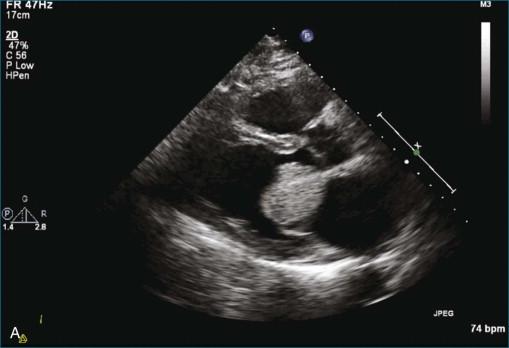
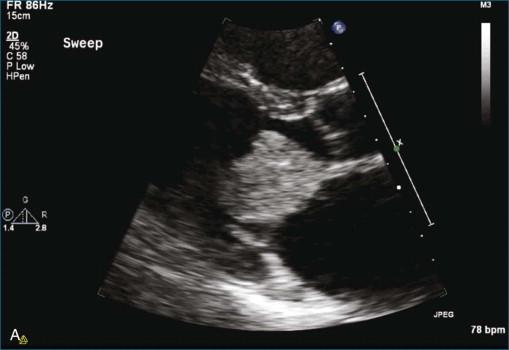
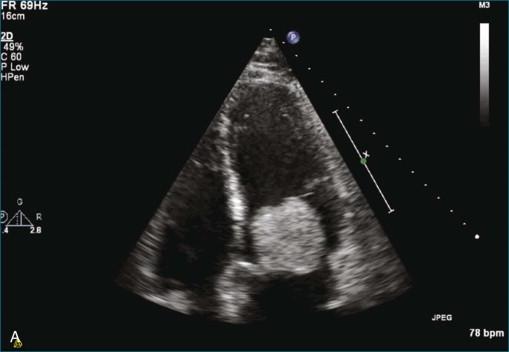
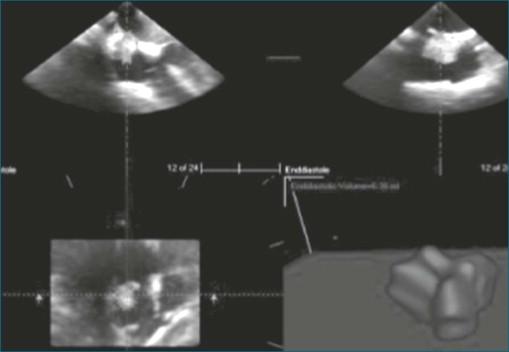
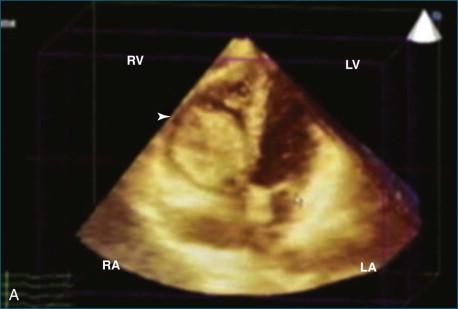
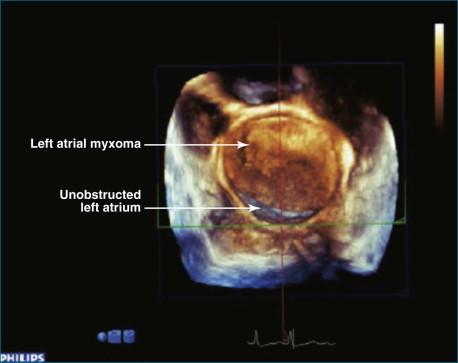
Prior to these publications, incremental value for the characterization of internal composition of masses and volume calculation had been appreciated with RT3DTTE imaging for myxomas and a hemangioma. In this small series, four left atrial tumors, including three myxomas and one hemangioma, were imaged by RT3D and correlated with histopathology specimens. Echolucencies suggestive of intramass hemorrhage were more frequently seen with 3D imaging compared with 2DE. In addition, 3DTTE detected more extensive and closely packed echolucencies involving the whole extent of the tumor in the hemangioma compared with more scattered echolucencies in myxomas ( Figure 16-7 ).
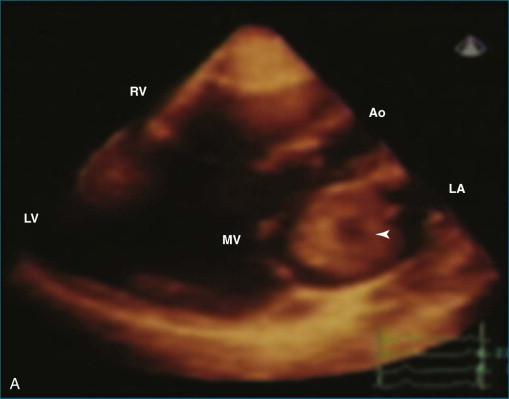
Fibroma is a congenital neoplasm that usually affects children. A right ventricular fibroma was diagnosed by 2DTTE in a patient with previous incomplete resection of the same. The fibroma ( Figure 16-8 ) was dramatically larger (9.0 × 2.8 cm) by RT3DTTE compared with 2DE (2.6 × 2.7 cm). A left atrial fibroma ( Figure 16-9 ) was associated with Gardner syndrome.
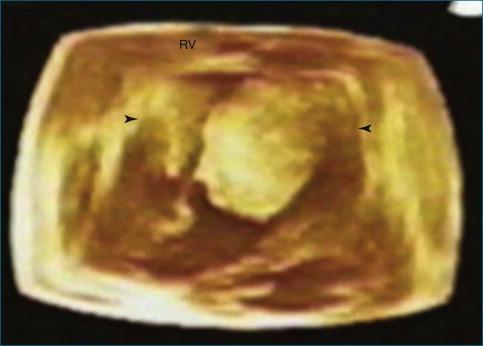
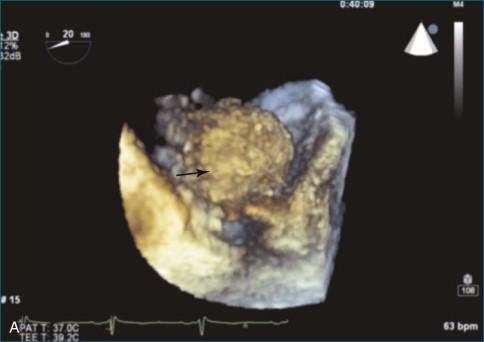
Become a Clinical Tree membership for Full access and enjoy Unlimited articles
If you are a member. Log in here